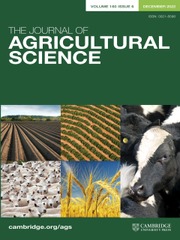Article contents
Carbon sequestration potential and sustainable yield index for groundnut- and fallow-based cropping systems
Published online by Cambridge University Press: 06 April 2006
Abstract
Soil organic carbon storage encompasses both soil productivity and environmental capabilities. The influence of fertilizer (nitrogen and phosphorus) levels (0 NP, 0·5 NP, 1·0 NP (recommended standard) or 1·5 NP) on total system productivity, sustainable yield index and soil organic carbon storage in Vertisols (Typic Haplustert) under groundnut and fallow-based cropping systems were examined in a field experiment over 6 years. The aim was to identify a system that provided an acceptable balance between total system productivity and soil organic carbon restoration. The experiment comprised two rainy season crops (groundnut or fallow) and five post-rainy season crops (wheat, mustard, chickpea, sunflower or summer groundnut), each post-rainy season crop with four levels of NP fertilizer. The total system productivity was 130% higher in the groundnut-based than in the fallow-based system and was in the order: groundnut–groundnut>groundnut–chickpea>groundnut–wheat>groundnut–mustard>groundnut–sunflower. The sustainable yield index was highest in the groundnut–groundnut system. The gross C input was relatively higher in the groundnut-based system but the C loss rate was greater. The amount of residue needed per ha per year to compensate for loss of soil organic carbon was estimated to be 4·3 t in the fallow-based and 7·6 t in the groundnut–based cropping system. Though the total system productivity was greater in groundnut–groundnut and groundnut–chickpea systems, soil organic carbon declined. The groundnut–wheat system contributed more C, particularly root biomass C, than other systems, improved the restoration of soil organic carbon and maintained total system productivity. It was concluded that current fertilizer recommendations are adequate for maintaining yields in groundnut-based systems but the addition of crop residues at regular intervals along with fertilizer is necessary to maintain restoration of soil organic carbon.
Information
- Type
- Crops and Soils
- Information
- Copyright
- © 2006 Cambridge University Press
- 17
- Cited by

